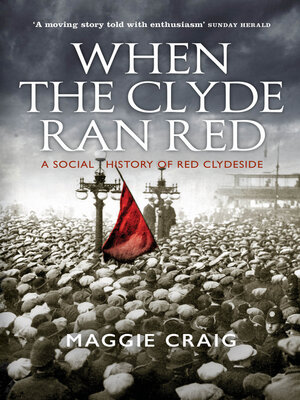
Sign up to save your library
With an OverDrive account, you can save your favorite libraries for at-a-glance information about availability. Find out more about OverDrive accounts.
Find this title in Libby, the library reading app by OverDrive.



Search for a digital library with this title
Title found at these libraries:
| Library Name | Distance |
|---|---|
| Loading... |
This social history chronicles the protest movements of early 20th century Glasgow and Western Scotland: “A moving story told with enthusiasm” (Sunday Herald, UK).
When the Clyde Ran Red paints a vivid picture of the heady days when revolution was in the air of Glasgow and surrounding areas along the River Clyde. Through the bitter strike at the Singer Sewing machine plant in Clydebank in 1911, Bloody Friday in Glasgow’s George Square in 1919, the General Strike of 1926 and on through the Spanish Civil War to the Clydebank Blitz of 1941, the people fought for the right to work, the dignity of labor, and a fairer society for everyone.
The Red Clydeside movement took hold in a Glasgow where overcrowded tenements stood no distance from elegant tea rooms, dance halls, and art galleries. The River Clyde was also home to the famous artists of the Glasgow Style and exhibitions showcasing the wonders of the age. Political idealism and artistic creativity were matched by industrial productivity—especially in ship and locomotive building. In this book Maggie Craig situates the politics of the time in the broader historical context, telling a story of social change and human drama.
When the Clyde Ran Red paints a vivid picture of the heady days when revolution was in the air of Glasgow and surrounding areas along the River Clyde. Through the bitter strike at the Singer Sewing machine plant in Clydebank in 1911, Bloody Friday in Glasgow’s George Square in 1919, the General Strike of 1926 and on through the Spanish Civil War to the Clydebank Blitz of 1941, the people fought for the right to work, the dignity of labor, and a fairer society for everyone.
The Red Clydeside movement took hold in a Glasgow where overcrowded tenements stood no distance from elegant tea rooms, dance halls, and art galleries. The River Clyde was also home to the famous artists of the Glasgow Style and exhibitions showcasing the wonders of the age. Political idealism and artistic creativity were matched by industrial productivity—especially in ship and locomotive building. In this book Maggie Craig situates the politics of the time in the broader historical context, telling a story of social change and human drama.







